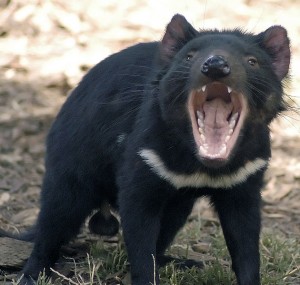THURSDAY, 23 FEBRUARY 2012
The saving grace is that at least you can’t catch cancer from sufferers. Not so for Tasmanian devils (Sarcophilus harrisii), which were already endangered prior to the appearance, in 1996, of a highly infectious cancer. This lethal devil facial cancer disease (DFCD) is not the result of bacteria or viruses but spreads via the transfer of cancerous Tasmanian devil cells between individuals, and causes extensive facial disfigurement.New findings, released this week, by Dr Elizabeth Murchison and her team have traced the origins of this unusual and exceptionally medically interesting cancer. Since infection depends on the transfer of cancer cells, every tumour has the same set of genes, derived from the devil that first contracted the disease; ‘the immortal devil’. This work has allowed scientists to identify the genetic changes that created the disease and which allow these cells to continue to grow out of control. Approximately 500 genes have been altered in these cells, including two genes known to be important in human cancers.
The most striking feature of this cancer is its ability to avoid detection by the immune system. Your immune system is capable of distinguishing your cells from those of any other living thing, and destroys any invading cells. This is why organ transplants can sometimes be rejected and why it is always important to match blood types during transfusions. Yet DFCD cells are able to easily infect new individuals without triggering any immune response.
Hence, studying this cancer doesn’t just prepare us for the unlikely eventuality of similar diseases occurring in humans; it may also help us to improve the success rate of organ transplant surgery. Moreover, the sequencing of this genome is a crucial step towards saving the Tasmanian devil from imminent extinction. In less than twenty years, DFCD has infected between 20% and 50% of the global population of devils and has spread throughout Tasmania, decimating several populations.
Government backed conservation schemes are well underway in Tasmania: focusing on preserving captive breeding populations while keeping them disease free is a formidable challenge. It is also impossible to reintroduce these captive devils into the wild until a treatment for this cancer is found.
Dr Murchison will be giving a talk about her work to the Cambridge Society for the Application of Research (CSAR) on 11th June 2012 at Churchill College. Membership and admission are free to members of the University of Cambridge. See here for more information.
Written by Jonathan Lawson
DOI 10.1016/j.cell.2011.11.065

